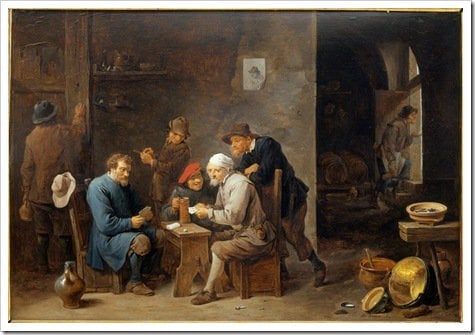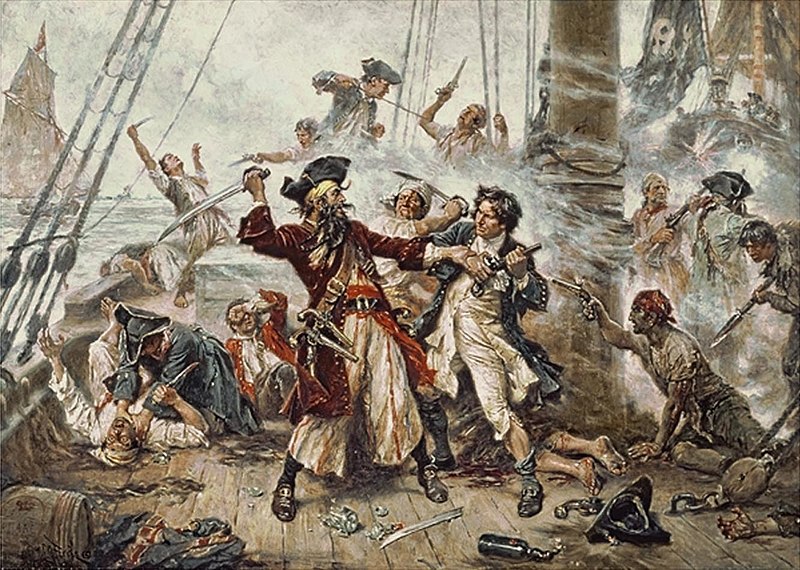Piracy has existed all over the globe, but I'm just talking about European pirates for now. Exploring the wardrobes of Asian pirates could easily take twice as long, and while indigenous North American peoples did engage in piracy, I don't know much about it.
Through the ages*:
The Sea Peoples
The Sea Peoples were a loose confederation of Aegean and Mediterranean pirates who preyed on Egyptian (and later, Phonecian) trade vessels. They are mentioned in hieroglyphics dating 3700-4000 years old. While the exact ethnic identity of the Sea Peoples is contested, it's theorized they were displaced Greeks. During Egypt's 20th Dynasty (Greece's Helladic period), both the Egyptians and the Greeks were wearing similar garments, based around a skirt-like garment of white linen secured with a belt. Greeks may have worn a knee-length tunic with a belt, but much of the limited art from the time shows men hanging out topless. Pirates generally would have been on the lower end of the economic scale, so a pirate of this time period would have been spotted in the simpler versions:

Goth Pirates (and their contemporaries)
A Goth pirate is not a sixteen year old Johnny Depp fan shopping at Hot Topic. The Goths were a Germanic tribe of Scandinavian origin, who showed up around the 3rd century AD and kept making trouble until the 8th century AD. The Goths were accomplished pirates of the Aegean, Black Sea, and Mediterranean. Goth pirates looked quite similar to Vikings, who arrive on the scene later, from similar cultural and ethnic roots. I was unable to find images depicting EARLY goths, but by the 5th and 6th centuries, Goths were wearing long belted tunics with trim and straight ankle-length pants which were bound from the knee to the ankle. They wore leather shoes or boots. I think this image slightly exaggerates the number of weapons you'd find on a Gothic pirate's person, and a spear and shield, while effective against mounted troops, wouldn't be all that helpful on a boat. A short, heavy sword with a slashing (rather than stabbing) design is a more typical sailor's weapon. While traditional Gothic forces made use of chain maille armor, seamen typically go without due to sinking damage.
Further West, Saxon pirates were harassing Romans in modern-day France. Saxon pirates would have looked very similar to Goths.

About the same time, Irish pirates kidnapped St. Patrick and sold him as a slave to an Irish farmer. This gives some insight about what pirates were doing in the 5th century in Europe. An Irish pirate would have been wearing a long tunic-like dress called a léine (which was worn by both men and women). Portraits of St. Patrick depict him wearing two léine layered together along with a cape. Other portraits of St. Patrick show a similar outfit with a belt, which would have been common for Irish men of his time. His pirate captors probably wore something similar (although the sleeves are a bit too narrow, the product of a portrait made significantly later):

Vikings
Though Vikings are frequently described as the "original" pirates, they didn't show up until the end of the 8th century AD and only stuck around until the mid 11th century. The lack of centralized governments made it easy for Scandanavian tribes to terrorize settlements in Western Europe, Italy, and even Northern Africa and North America. Vikings dressed very similarly to Goths, with loose, long tunics and straight pants bound from the knee down. The only significant difference is that since the Vikings came from colder climates, they were likely to have worn more fur.
The Neretva, The Baltics, and The Uskoks
Starting in about the 8th century AD, several Slavic tribes spread out across Europe took to piracy. The Neretva preyed on Venetian merchants until the early 13th century. While the Venetian navy was stationed locally, they'd sign truces and leave Italy alone, but while the navy was occupied elsewhere, they'd terrorize Venice and Sicily. The Baltic Slavs didn't have a highly developed agricultural system and were driven to piracy to avoid economic collapse, terrorizing the Baltic Sea from the 9th century AD to the end of the 14th century. Finally, the Uskoks were underpaid Slavic soldiers in the Adriatic who turned to part-time piracy to supplement their income. Weekend pirates. Hobby pirates. In any case, the Slavs were cultural and ethnic descendants from Viking settlers in modern-day Russia, and their wardrobe was very similar. Since the Slavic tribes settled southern Europe and traveled even further south, their versions of the Viking tunics are lighter, with shorter sleeves and vests rather than cloaks. They also seem to leave their pants loose rather than binding them below the knee.

About the same time, Arab pirates (who would have dressed much like the men on the left side of the above picture, in long, loose robes) were also exploiting opportunities in the Adriatic and the Mediterranean. Muslim pirates established secret pirate havens, often on small islands.
Early Criminal Pirates
Piracy was officially outlawed in the 13th and 14th centuries (depending on the country), and governments started prosecuting individuals for the crime of piracy in addition to their individual acts. In 1241, a man convicted of piracy in England became the first man to be hanged, drawn and quartered, which I think must be the most horrible way someone could possibly be executed. During the 13th century in England and throughout much of Europe, men typically wore very long tunics, but working men wore shorter tunics and leggings, and would tuck their tunics into their belts for freedom of motion. I believe a sailor would likely have worn something akin to the working man's garb.

The Golden Age of Piracy (or, Pirates of the Caribbean)
From the mid 16th century to the early 18th century, colonization and war in the new world brought thousands of sailors, soldiers, and settlers to North and South America. English, Dutch, and French pirates and privateers raided the Spanish-controlled Caribbean and established famed pirate-friendly trading hubs like Tortuga and Port Royal. Meanwhile, pirates plundered and traded from New York to the Gulf of Mexico and beyond. Cuba was considered pirate-friendly into the 19th century, by which time most pirates had turned to slave trade.
The average sailor might have worn something like these men. Short pants, buttoned jackets, collared shirts, white or colored knee-high socks secured with garters, and leather shoes.

The captain, or a particularly successful crew, or a privateer of station (of whom there were several) might wear something more like the pirates we see in movies and ads. This depiction of the capture of Blackbeard has some familiar elements:

Many individual elements of the public's imagination of a pirate is more or less accurate to late 17th into 18th century fashion, but most pirates wouldn't have worn the latest fashions because they were sailors. Even on a successful ship, the individual sailor probably had neither the resources nor the storage space to waste on fancy clothes.
The Golden Age is the end of notable European piracy. The availability of slightly more legit work in the form of slave trade and the popularity of executing pirates in the 17th and 18th centuries caused piracy to dry up (no pun intended).
*I'm only talking about what men wore during these periods because female sailors were aberrant in pretty much all these periods, and if a woman did go to sea she was likely dressed as a man, either to conceal her sex or simply for practicality.
 I'm thrilled to see it coming together to this point.
I'm thrilled to see it coming together to this point. Salome in the 1510s-1530s, Giampietrino
Salome in the 1510s-1530s, Giampietrino






 Last week I had a sewing day with my friend Niyo, where I started working on a Turkish entari made from a recycled duvet cover. The duvet cover was a lovely satin-finish cotton with green on green stripes. It seems everyone I know has a set of sheets in the same pattern (mine are black), but it was a nice lightweight cotton with very little stretch, so I knew it would be a sturdy and comfortable option for an entari, which is a support garment.
Last week I had a sewing day with my friend Niyo, where I started working on a Turkish entari made from a recycled duvet cover. The duvet cover was a lovely satin-finish cotton with green on green stripes. It seems everyone I know has a set of sheets in the same pattern (mine are black), but it was a nice lightweight cotton with very little stretch, so I knew it would be a sturdy and comfortable option for an entari, which is a support garment.